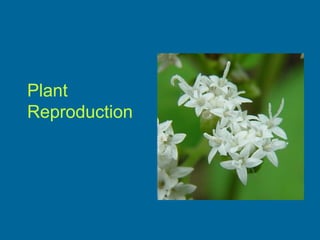
Plants reproduction moodle
- 2. Introduction • A flower has a set of adaptations – Petals have modified leaves – Entire flower is a highly modified branch • Flower shape, scent, color attracts insects, thereby ensuring the reproduction of the plant
- 4. Flower • Function – To produce seeds for reproduction
- 5. Terminology • Whorl – Arrangement of three or more leaves, petals, or other organs radiating from the plant • Non-essential flower parts – Not directly involved in reproduction • Essential flower parts – Directly involved in reproduction
- 6. Parts of the Flower • Receptacle – Base of the flower
- 7. Parts of the Flower • Sepals – Non-essential parts of the flower – Compose the first whorl – Collectively known as the calyx
- 9. Parts of the Flower • Petals – Non-essential parts of the flower • Compose the second whorl • Collectively known as the corolla
- 11. Parts of the Flower • Stamen – Essential flower parts • Compose the third whorl • Male reproductive organ –Anther : Produces pollen (contains sperm cells) –Filament : Supports the anther
- 14. Parts of the Flower • Carpels – Essential flower parts – Compose the last, fourth whorl – Usually fused to make a single pistil – Female reproductive organ
- 15. Carpels vs. Pistils • (A) shows a single pistil consisting of several fused carpels • (B) shows several pistils, each consisting of a single carpel
- 16. Parts of the flower • Female reproductive organ – Ovary : Swollen base of the pistil (contains ovules, which contain egg cells) – Style: Stalk of the pistil – Stigma: Tip of the pistil, sticky to capture falling pollen
- 19. Types of Flowers • Perfect – Has both pistils and stamens in the same flower – Have all 4 whorls of modified leaves • Imperfect – Has either pistil or stamens in the same flower – Missing one or more flower parts – Two types • Monoecious • Dioecious
- 20. Imperfect Flowers • Monoecious – “Same house” – Separate male and female flowers on the same plant – Example • Corn
- 24. Imperfect Flowers • Dioecious – “Two houses” – Flowers are all male or all female on the same plant – Example • Ginko tree –Most are male –Female produces seeds with foul odor